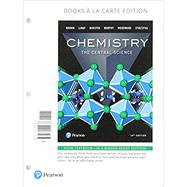This loose-leaf, three-hole punched version of the textbook gives students the flexibility to take only what they need to class and add their own notes — all at an affordable price.
DIGITAL UPDATE available for Fall 2020 classes
For courses in two-semester general chemistry.
A robust digital experience built for student success in general chemistry
Chemistry: The Central Science approaches general chemistry with unrivaled problem sets, notable scientific accuracy and currency, and remarkable clarity. The dynamic author team builds on their expertise and experience as leading researchers and award-winning teachers to help students develop conceptual understanding and to think about the practical, real-world use of chemistry. Data-driven problem and question revisionsby theauthors incorporate educational research, teacher preferences, and data from thousands of student users.
Personalize learning with Mastering Chemistry
By combining trusted author content with digital tools and a flexible platform, Mastering personalizes the learning experience and improves results for each student. Mastering Chemistry provides an extension of learning, allowing students a platform to practice, learn, and apply knowledge outside of the classroom.
0134557328 / 9780134557328 Chemistry: The Central Science, Books a la Carte Plus MasteringChemistry with Pearson eText -- Access Card Package
Package consists of:
- 0134294165 / 9780134294162 MasteringChemistry with Pearson eText -- ValuePack Access Card -- for Chemistry: The Central Science
- 0134555635 / 9780134555638 Chemistry: The Central Science, Books a la Carte Edition






